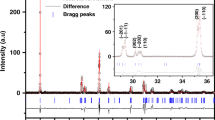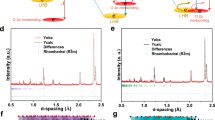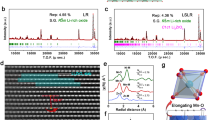Abstract
Li[LixNiyMnzCo1−x−y−z]O2 (lithium-rich NMCs) are benchmark cathode materials receiving considerable attention due to the abnormally high capacities resulting from their anionic redox chemistry. Although their anionic redox mechanisms have been much investigated, the roles of cationic redox processes remain underexplored, hindering further performance improvement. Here we decoupled the effects of nickel and cobalt in lithium-rich NMCs via a comprehensive study of two typical compounds, Li1.2Ni0.2Mn0.6O2 and Li1.2Co0.4Mn0.4O2. We discovered that both Ni3+/4+ and Co4+, generated during cationic redox processes, are actually intermediate species for triggering oxygen redox through a ligand-to-metal charge-transfer process. However, cobalt is better than nickel in mediating the kinetics of ligand-to-metal charge transfer by favouring more transition metal migration, leading to less cationic redox but more oxygen redox, more O2 release, poorer cycling performance and more severe voltage decay. Our work highlights a compositional optimization pathway for lithium-rich NMCs by deviating from using cobalt to using nickel, providing valuable guidelines for future high-capacity cathode design.
This is a preview of subscription content, access via your institution
Access options
Access Nature and 54 other Nature Portfolio journals
Get Nature+, our best-value online-access subscription
$29.99 / 30 days
cancel any time
Subscribe to this journal
Receive 12 print issues and online access
$259.00 per year
only $21.58 per issue
Buy this article
- Purchase on Springer Link
- Instant access to full article PDF
Prices may be subject to local taxes which are calculated during checkout





Similar content being viewed by others
Data availability
Source data are provided with this paper. All data supporting the findings of this Article and its Supplementary Information will be made available upon reasonable request to the authors. Source data are provided with this paper.
References
Li, W., Erickson, E. M. & Manthiram, A. High-nickel layered oxide cathodes for lithium-based automotive batteries. Nat. Energy 5, 26–34 (2020).
Rozier, P. & Tarascon, J. M. Review—Li-rich layered oxide cathodes for next-generation Li-ion batteries: chances and challenges. J. Electrochem. Soc. 162, A2490–A2499 (2015).
Yu, H. & Zhou, H. High-energy cathode materials (Li2MnO3–LiMO2) for lithium-ion batteries. J. Phys. Chem. Lett. 4, 1268–1280 (2013).
Assat, G. & Tarascon, J.-M. Fundamental understanding and practical challenges of anionic redox activity in Li-ion batteries. Nat. Energy 3, 373–386 (2018).
Li, B. & Xia, D. Anionic redox in rechargeable lithium batteries. Adv. Mater. 29, 1701054 (2017).
Gent, W. E., Abate, I. I., Yang, W., Nazar, L. F. & Chueh, W. C. Design rules for high-valent redox in intercalation electrodes. Joule 4, 1369–1397 (2020).
Eum, D. et al. Voltage decay and redox asymmetry mitigation by reversible cation migration in lithium-rich layered oxide electrodes. Nat. Mater. 19, 419–427 (2020).
Lu, Z. & Dahn, J. R. Understanding the anomalous capacity of Li/Li[NixLi(1/3−2x/3)Mn(2/3−x/3)]O2 cells using in situ X-ray diffraction and electrochemical studies. J. Electrochem. Soc. 149, A815 (2002).
Armstrong, A. R. et al. Demonstrating oxygen loss and associated structural reorganization in the lithium battery cathode Li[Ni0.2Li0.2Mn0.6]O2. J. Am. Chem. Soc. 128, 8694–8698 (2006).
Robertson, A. D. & Bruce, P. G. The origin of electrochemical activity in Li2MnO3. Chem. Commun. 2790–2791 (2002).
Lu, Z., Beaulieu, L. Y., Donaberger, R. A., Thomas, C. L. & Dahn, J. R. Synthesis, structure, and electrochemical behavior of Li[NixLi1/3−2x/3Mn2/3−x/3]O2. J. Electrochem. Soc. 149, A778 (2002).
Yabuuchi, N., Yoshii, K., Myung, S. T., Nakai, I. & Komaba, S. Detailed studies of a high-capacity electrode material for rechargeable batteries, Li2MnO3–LiCo(1/3)Ni(1/3)Mn(1/3)O2. J. Am. Chem. Soc. 133, 4404–4419 (2011).
Hy, S., Felix, F., Rick, J., Su, W.-N. & Hwang, B. J. Direct in situ observation of Li2O evolution on Li-rich high-capacity cathode material, Li[NixLi(1–2x)/3Mn(2–x)/3]O2 (0 ≤ x ≤ 0.5). J. Am. Chem. Soc. 136, 999–1007 (2014).
Assat, G. et al. Fundamental interplay between anionic/cationic redox governing the kinetics and thermodynamics of lithium-rich cathodes. Nat. Commun. 8, 2219 (2017).
Li, X. et al. Direct visualization of the reversible O(2−)/O(−) redox process in Li-rich cathode materials. Adv. Mater. 30, e1705197 (2018).
Zhang, M. et al. Pushing the limit of 3d transition metal-based layered oxides that use both cation and anion redox for energy storage. Nat. Rev. Mater. 7, 522–540 (2022).
Li, M. et al. Cationic and anionic redox in lithium-ion based batteries. Chem. Soc. Rev. 49, 1688–1705 (2020).
Yabuuchi, N. et al. High-capacity electrode materials for rechargeable lithium batteries: Li3NbO4-based system with cation-disordered rocksalt structure. Proc. Natl Acad. Sci. USA 112, 7650–7655 (2015).
Seo, D. H. et al. The structural and chemical origin of the oxygen redox activity in layered and cation-disordered Li-excess cathode materials. Nat. Chem. 8, 692–697 (2016).
Rong, X. et al. Structure-induced reversible anionic redox activity in Na layered oxide cathode. Joule 2, 125–140 (2018).
Hong, J. et al. Metal–oxygen decoordination stabilizes anion redox in Li-rich oxides. Nat. Mater. 18, 256–265 (2019).
Luo, K. et al. Charge-compensation in 3d-transition-metal-oxide intercalation cathodes through the generation of localized electron holes on oxygen. Nat. Chem. 8, 684–691 (2016).
Tsuchimoto, A. et al. Nonpolarizing oxygen-redox capacity without O–O dimerization in Na2Mn3O7. Nat. Commun. 12, 631 (2021).
McCalla, E. et al. Visualization of O–O peroxo-like dimers in high-capacity layered oxides for Li-ion batteries. Science 350, 1516–1521 (2015).
Ning, F. et al. Inhibition of oxygen dimerization by local symmetry tuning in Li-rich layered oxides for improved stability. Nat. Commun. 11, 4973 (2020).
House, R. A. et al. Superstructure control of first-cycle voltage hysteresis in oxygen-redox cathodes. Nature 577, 502–508 (2020).
Johnson, C. S. et al. The significance of the Li2MnO3 component in ‘composite’ xLi2MnO3·(1−x)LiMn0.5Ni0.5O2 electrodes. Electrochem. Commun. 6, 1085–1091 (2004).
Francis Amalraj, S. et al. Study of the electrochemical behavior of the ‘inactive’ Li2MnO3. Electrochim. Acta 78, 32–39 (2012).
Li, B. et al. Correlating ligand-to-metal charge transfer with voltage hysteresis in a Li-rich rock-salt compound exhibiting anionic redox. Nat. Chem. 13, 1070–1080 (2021).
Li, B. et al. Capturing dynamic ligand-to-metal charge transfer with a long-lived cationic intermediate for anionic redox. Nat. Mater. 21, 1165–1174 (2022).
Bréger, J. et al. High-resolution X-ray diffraction, DIFFaX, NMR and first principles study of disorder in the Li2MnO3–Li[Ni1/2Mn1/2]O2 solid solution. J. Solid State Chem. 178, 2575–2585 (2005).
Wu, F. et al. Preparation and electrochemical performance of Li-rich layered cathode material, Li[Ni0.2Li0.2Mn0.6]O2, for lithium-ion batteries. J. Appl. Electrochem. 40, 783–789 (2010).
Sun, Y.-K., Lee, D.-J., Lee, Y. J., Chen, Z. & Myung, S.-T. Cobalt-free nickel rich layered oxide cathodes for lithium-ion batteries. ACS Appl. Mater. Interfaces 5, 11434–11440 (2013).
Xu, J. et al. Elucidating anionic oxygen activity in lithium-rich layered oxides. Nat. Commun. 9, 947 (2018).
Dai, K. et al. High reversibility of lattice oxygen redox quantified by direct bulk probes of both anionic and cationic redox reactions. Joule 3, 518–541 (2019).
Zhuo, Z. et al. Cycling mechanism of Li2MnO3:Li–CO2 batteries and commonality on oxygen redox in cathode materials. Joule 5, 975–997 (2021).
Ben Yahia, M., Vergnet, J., Saubanere, M. & Doublet, M. L. Unified picture of anionic redox in Li/Na-ion batteries. Nat. Mater. 18, 496–502 (2019).
Sathiya, M. et al. Reversible anionic redox chemistry in high-capacity layered-oxide electrodes. Nat. Mater. 12, 827–835 (2013).
Saubanère, M., McCalla, E., Tarascon, J. M. & Doublet, M. L. The intriguing question of anionic redox in high-energy density cathodes for Li-ion batteries. Energy Environ. Sci. 9, 984–991 (2016).
Hu, E. et al. Oxygen-redox reactions in LiCoO2 cathode without O–O bonding during charge–discharge. Joule 5, 720–736 (2021).
Boulineau, A., Simonin, L., Colin, J. F., Bourbon, C. & Patoux, S. First evidence of manganese–nickel segregation and densification upon cycling in Li-rich layered oxides for lithium batteries. Nano Lett. 13, 3857–3863 (2013).
Yin, W. et al. Structural evolution at the oxidative and reductive limits in the first electrochemical cycle of Li1.2Ni0.13Mn0.54Co0.13O2. Nat. Commun. 11, 1252 (2020).
Kitchaev, D. A., Vinckeviciute, J. & Van der Ven, A. Delocalized metal–oxygen π-redox is the origin of anomalous nonhysteretic capacity in Li-ion and Na-ion Cathode materials. J. Am. Chem. Soc. 143, 1908–1916 (2021).
Voronina, N., Sun, Y.-K. & Myung, S.-T. Co-free layered cathode materials for high energy density lithium-ion batteries. ACS Energy Lett. 5, 1814–1824 (2020).
Li, B. et al. Constructing ‘Li-rich Ni-rich’ oxide cathodes for high-energy-density Li-ion batteries. Energy Environ. Sci. 16, 1210–1222 (2023).
Rodríguez-Carvajal, J. Recent advances in magnetic structure determination by neutron powder diffraction. Phys. B 192, 55–69 (1993).
Briois, V. et al. ROCK: the new Quick-EXAFS beamline at SOLEIL. J. Phys. Conf. Ser. 712, 012149 (2016).
Ravel, B. & Newville, M. ATHENA, ARTEMIS, HEPHAESTUS: data analysis for X-ray absorption spectroscopy using IFEFFIT. J. Synchrotron Radiat. 12, 537–541 (2005).
Zhang, L., Tsolakidou, C., Mariyappan, S., Tarascon, J.-M. & Trabesinger, S. Unraveling gas evolution in sodium batteries by online electrochemical mass spectrometry. Energy Storage Mater. 42, 12–21 (2021).
Acknowledgements
This research used resources of the Advanced Photon Source, a US Department of Energy (DOE) Office of Science User Facility, operated for the DOE Office of Science by Argonne National Laboratory under contract number DE-AC02-06CH11357, and resources of the Advanced Light Source, which is a DOE Office of Science User Facility under contract no. DE-AC02-05CH11231. Hard XAS experiments were performed on the ROCK beamline at the SOLEIL Synchrotron. We appreciate help from S. Mariyappan with performing the TGA and DSC experiments. A.V.M. and A.M.A. are grateful to the Russian Science Foundation for financial support (grant 23-73- 30003). J.-M.T and B.L. acknowledge funding from the European Research Council (ERC) (FP/2014)/ERC Grant-Project 670116-ARPEMA. We dedicate this article to J.B. Goodenough, as it deals with the layered oxides and fundamentals of electronic structure and redox chemistry in solid state that were so dear to the heart of John, the inspirer of so many of us.
Author information
Authors and Affiliations
Contributions
B.L. and J.-M.T. planned the project and designed the experiments. B.L. carried out the synthesis, structural characterization and electrochemical analysis. X.G. prepared some of the samples for RIXS and performed the operando XRD experiment of LNMCO compound. Z.Z., J.G. and W.Y. collected and analysed the RIXS and soft XAS data. A.I. collected and processed the hard XAS data. A.V.M. and A.M.A. performed TEM experiments and did the analysis. L.Z. performed the OEMS experiments and data analysis. B.L., J.-M.T. and A.M.A. discussed the results and wrote the paper with the contributions from all other authors.
Corresponding author
Ethics declarations
Competing interests
The authors declare no competing interests.
Peer review
Peer review information
Nature Materials thanks Valerie Pralong and Naoaki Yabuuchi for their contribution to the peer review of this work.
Additional information
Publisher’s note Springer Nature remains neutral with regard to jurisdictional claims in published maps and institutional affiliations.
Extended data
Extended Data Fig. 1 OEMS results of LNMO and LCMO.
OEMS results for (a–c) LNMO and (d–f) LCMO. The cells were cycled at a current density of 15 mA g-1. The amount of O2 and CO2 release were indicated. The loss of O was calculated as percentage of O in the formula and shown as the loss of stoichiometry. ‘P1’ and ‘P2’ label the CO2 release peaks corresponding to different originations but with different intensities in LNMO and LCMO. The first peak P1 starts at ~4 V and normally can be attributed to the chemical/electrochemical decomposition of surface Li2CO3 residue, and their evolution rates depend on the amount of surface carbonate residuals after synthesis. The second peak P2 at the end of charge generally originates from electrolyte decomposition, and can be partially related to the singlet O species generated during oxygen release that can react with electrolyte to form CO2. The smaller amount of CO2 release in LNMO can hence be explained by its smaller oxygen release or less oxidized oxygen (shorter 4.5 V plateau) compared with that of LCMO.
Extended Data Fig. 2 TEM results of LNMO and LCMO after 40 cycles.
TEM images of LNMO and LCMO before and after 40 cycles. (a) [010] and (b) [\(\bar{1}10\)] HAADF-STEM images and corresponding SAED patterns of discharged LNMO after 40 cycles. Main reflections in the SAED patterns can be indexed in the parent O3-trigonal structure (space group: R\(\bar{3}\)m), whereas additional h ± 1/2 0 l and h ± 1/2 k ± 1/2 l reflections appear in both [010] and [\(\bar{1}10\)] SAED patterns of cycled LNMO. These extra spots indicate a formation of a tetragonally distorted I41/amd spinel structure aroused from TM migration from their initial positions (3a) towards both empty Li sites (3b) and tetrahedrally coordinated interstices in FCC oxygen lattice. An interlayer migration of the TM cations to Li layers is also directly evidenced in HAADF-STEM images, since extra HAADF intensity is observed between the (Li,TM)O2 layers. Besides interlayer, pronounced irreversible intra-layer TM cation migration is clearly seen in (b) [\(\bar{1}10\)] HAADF-STEM, that is a typical sign of structure densification. However, in LNMO material the densified layer is confined to near surface area and does not exceed few nm in thickness, while the diffuse intensity lines (marked with white arrowheads) are recognizable in [\(\bar{1}10\)] SAED pattern as well as double-dot contrast typical for Li/TM ‘honeycomb’ ordering is preserved in a bulk part of LNMO. (c) [010] and (d) [\(\bar{1}10\)] HAADF-STEM images and corresponding SAED patterns of the discharged LСMO after 40 cycles. A large fraction of the TM cations moves to Li layers and tetrahedral voids forming spinel-like nano domains clearly visible in [010] HAADF-STEM image. The ‘honeycomb’ Li/M ordering is completely suppressed in cycled LCMO: no diffuse intensity is observed in [\(\bar{1}10\)] SAED patterns and the dots in Li/TM layers are uniformly spaced and have similar brightness in [\(\bar{1}10\)] HAADF-STEM image. Altogether, such significant structural degradation indicates much higher degree of ‘densification’ of LCMO, where it propagates through all observed area compared to LNMO where it is confined to the near-surface layer. The scale bar is 2 nm.
Supplementary information
Supplementary Information
Supplementary Figs. 1–29, Note I and Tables 1–7.
Source data
Source Data Fig. 1
Source data of electrochemical profiles and XRD refinements.
Source Data Fig. 2
Source data of electrochemistry and XAS.
Source Data Fig. 3
Source data of electrochemistry and XAS.
Source Data Fig. 4
Source data of electrochemistry and in situ XRD.
Source Data Fig. 5
Source data of electrochemistry.
Rights and permissions
Springer Nature or its licensor (e.g. a society or other partner) holds exclusive rights to this article under a publishing agreement with the author(s) or other rightsholder(s); author self-archiving of the accepted manuscript version of this article is solely governed by the terms of such publishing agreement and applicable law.
About this article
Cite this article
Li, B., Zhuo, Z., Zhang, L. et al. Decoupling the roles of Ni and Co in anionic redox activity of Li-rich NMC cathodes. Nat. Mater. 22, 1370–1379 (2023). https://doi.org/10.1038/s41563-023-01679-x
Received:
Accepted:
Published:
Issue Date:
DOI: https://doi.org/10.1038/s41563-023-01679-x
This article is cited by
-
Tuning oxygen redox via transition-metal cation species
Science China Chemistry (2023)



